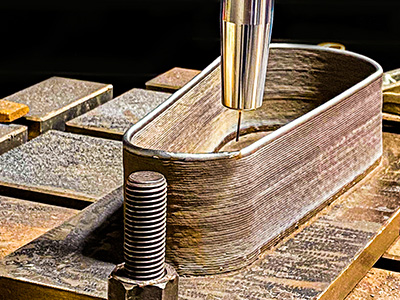What is Additive Manufacturing (WAAM)
Elements such as a clean environment, low cost, speed in production and raw material savings have led to the emergence of the method in the industry under the names "3D-Printing" or "Additive Manufacturing." Additive manufacturing is based on the principle of creating (mainly using welding technology) a geometric structure by stacking the raw material in the form of layers without removing machining, as opposed to traditional machining methods.
"Wire Arc Additive Manufacturing - WAAM," which is one of the additive manufacturing methods, is the most suitable additive manufacturing method for low production costs, high deposition rates, and the production of fast and large parts. The name WAAM is given to the production of parts with robotic welding technology according to the 3D drawing of the part to be produced using welding wire. In our content, the details of the question of what is additive manufacturing, which is one of the topics that are a matter of curiosity in the sector, are included.
Other additive manufacturing methods generally use metal powder instead of welding wire, and laser beam or electron beam as arc welding. Since there is still no strong metal powder production technology in our country, additive production using powder has to be entirely dependent on abroad. Another disadvantage of these powders imported from abroad is that they have high cost.
Advantages of Additive Manufacturing (WAAM)
Unlike traditional subtractive methods, the WAAM method is based on a layer-by-layer part production approach. Thanks to this, the material is collected only in the required dimensions and close to its final shape, and the material is saved. With the WAAM method, metallic parts can be produced on a larger scale than powder-based additive manufacturing methods. As the robot arm used in the process has more mobility as it can reach, it allows the production of large and complex parts that cannot be produced by powder-based methods.
The WAAM process is a method that also allows for personalized production. It reduces production investment costs for manufacturers with a varying product range. It also provides cost savings in mold design and workmanship as no special gauge/mold tools are needed during the production phase. It provides efficiency by reducing labor and time. Because it is also used in repair maintenance and repair works, it also makes it possible to manufacture spare parts fast. The welding wire used as a feed material in the WAAM process is cheaper and has higher accessibility than the metal powders used in powder-based methods. As the WAAM process is a resource-based method, it consists of cheaper and ready-made equipment compared to other methods. The surface treatments in the WAAM process are relatively less compared to other additive manufacturing methods, and it enables the production of the parts desired to be produced with the closest versions to their final state.
Uses of Additive Manufacturing
Additive manufacturing method can be used in many fields, particularly in aviation and space, automotive, maritime, oil & gas, and renewable energy sectors.
Innovative Applications
Istanbul Gedik University Welding Technology Application and Research Center and Gedik Welding R&D Center conduct joint R&D studies on innovative applications of WAAM Technology. Dr. Uğur Gürol, Welding Technology Application & Research Center and Gedik Test Center Manager, says that this knowledge of Gedik Welding, which can develop and produce welding wires with different characteristics used in WAAM Technology in accordance with WAAM and apply them with a robotic system, has a strategic importance for the technology in question.
Gürol said, “The welding wire (as solid or cored wire) required for WAAM is made suitable for this technology by making the necessary improvements. The GeKa WAAM Product Catalogue and system will be presented to the market at the SCHWEISSES & SCHNEIDEN Fair to be held in Germany soon.”
Within the scope of WAAM projects carried out in partnership with Gedik Welding R&D Center and Istanbul Gedik University with this purpose, the first parts have been produced successfully by using solid and cored welding wires and a welding robot. At the same time, he stated that these studies are supported by national and international projects.
Future Targes
The R&D studies conducted at Gedik Kaynak R&D Center are aimed at producing this technology with the welding technology of “Bi-Material;” that is, complex parts containing more than one material. The additive manufacturing method carried out using two different materials in the future manufacturing sector is particularly important for the defense industry. In this field, it was aimed to create a product by using two different materials (for example, low alloy welding wire and stainless welding wire) in the additive manufacturing method in the Gedik Kaynak R&D center, and the results of the studies were turned into scientific articles and published in "The International Congress on 3D Printing (Additive Manufacturing) Technologies and Digital Industry” (3D-PTC2021).
